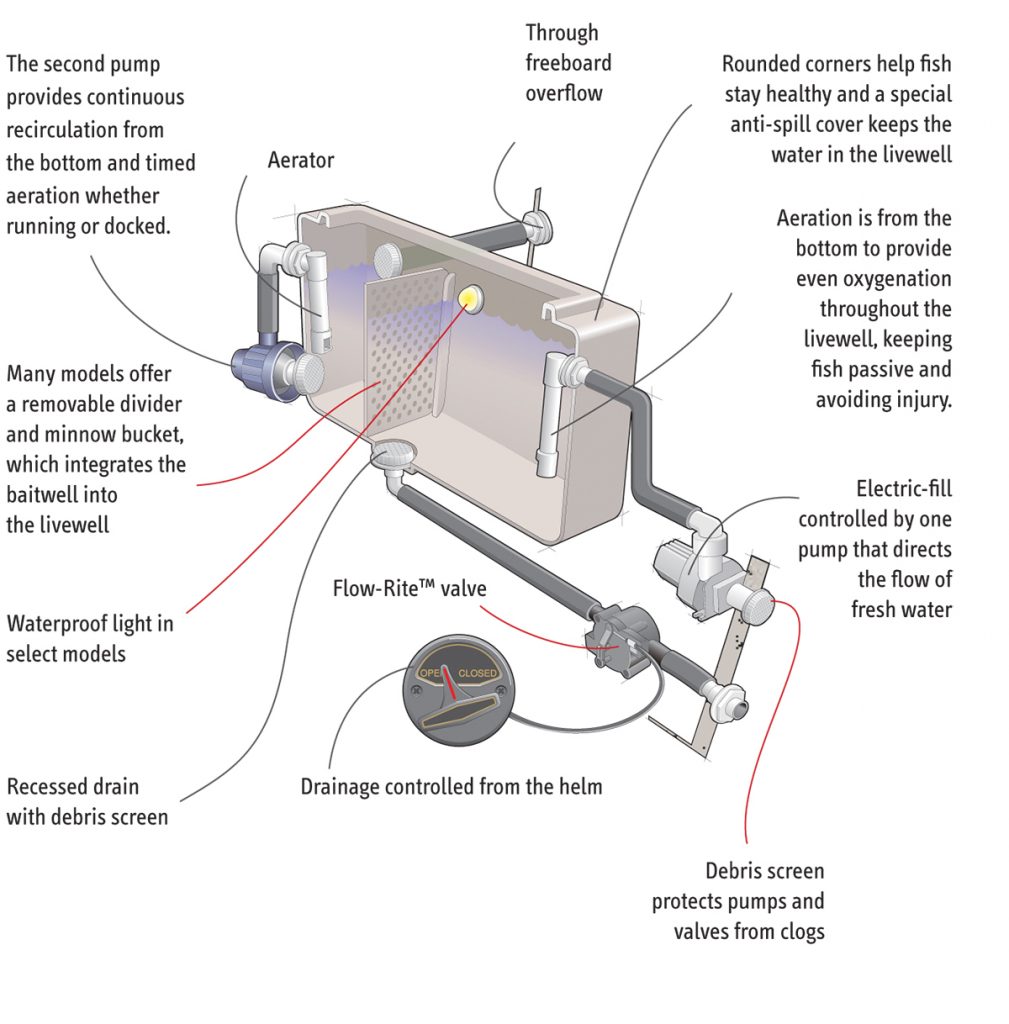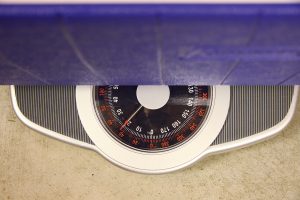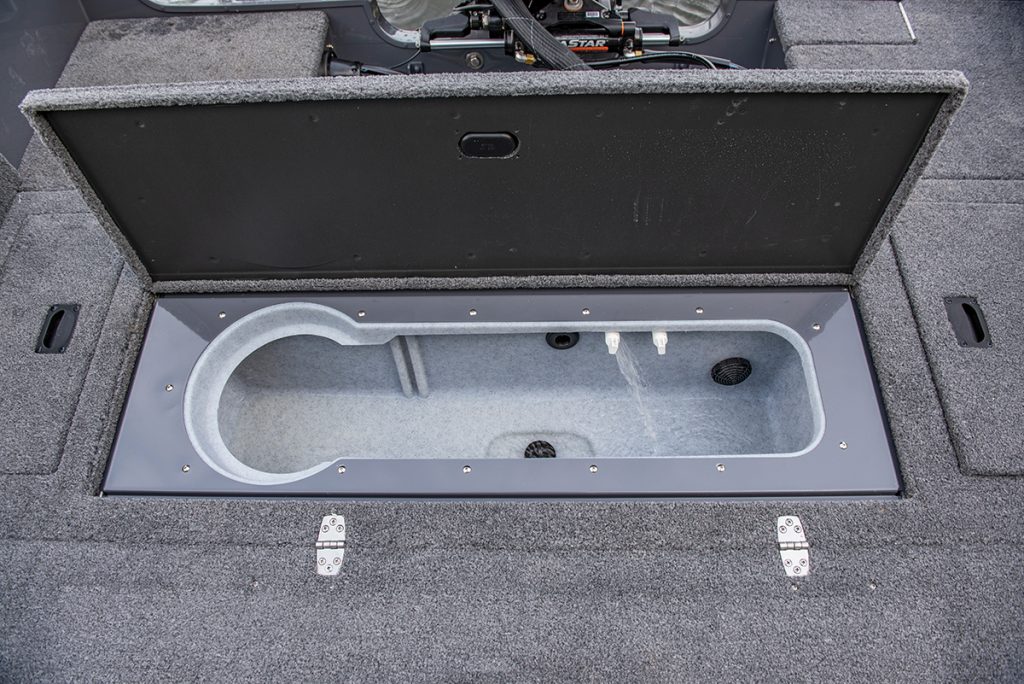All’s Well That’s Live Well
By Cam McRae
I’m embarrassed to admit it, but I’ve never thought much about livewells. When Diana and I review a boat so-equipped, we’ll make note of it, usually as part of the standard equipment. We might go on to comment on its capacity or whether the tank is properly positioned in the hull. (An offset livewell can upset the centre of gravity. Full of water they’re heavy!) But, that’s it. When I embarked on this article, I discovered a new world of livewells, bait wells and fish boxes.
Back when I had the time and opportunity to regularly engage in fishing, minnows or other live bait critters were kept in a “bait bucket” and the catch, headed for the frying pan, was clipped to a stringer and hung over the side. In the ensuing years, angling has become the fastest growing and is now one of the most popular outdoor pastimes. A large part of that has been stimulated by the glamour of “tournament fishing”, professional and talented amateur anglers vying for huge monetary prizes – all dependent on the size of their catch. A second major factor has been the move to “catch-and-release”. For weekend fishing buddies, catch-and-release allows for more sport, not hindered by limits. Catch as many as you want, carefully release them and keep only a few for supper. Most tournament fishing entails catch-and-release. The fish have to be healthy at the weigh-in and some tourneys require that the fish swim away without difficulty. “Brag-and-release” is another fun development. Keep that lunker alive and happy until you show him to your pals. Then, off he goes.

“Fish box” is a term borrowed from our saltwater neighbours south of the Mason-Dixon. Often erroneously applied to any fish holding container, it means what it says – a box, usually insulated and well supplied with ice. A place to keep the catch, not alive, just out of the hot sun until the boat gets back to the dock. Those massive coolers found under the helm seats of many bluewater boats aren’t there for beer and lunch. That’s a fish box. (Often shared with beer and lunch. I’m told that there are guys who swear that their end-of-day beverage doesn’t taste right unless it has spent most of that day nestled in with a bunch of snapper.)
Which brings us right back to livewells. Keeping bass, walleye or lakers alive and motivated requires more than a simple box full of water. But that’s where it started. Anglers filled big beer coolers with water to hold their catch. Soon, boat builders began to add fibreglass or aluminum “tanks”, usually with drains, to any of their craft likely to be used as a fish chaser. The tanks had to be filled with a bucket, and for a short while, kept fish or bait alive. Often just barely, sometimes not at all. Three or four good fish, a school of minnows or two dozen shrimp in a twenty gallon tank quickly dirty up the water and use up the oxygen. Not surprisingly, it was enterprising anglers that first added aeration and circulation systems to their on-board aquaria and the manufacturers quickly followed suit.
Not all live wells are created equal, however. Many still provide nothing more than a tank with a drain. Some add circulation, aeration or both. A few have a pump that allows for fresh water pickup. So, just finding “30 gallon livewell” on a boat’s equipment list doesn’t guarantee that the tank will serve your needs. Our friends at Princecraft, for example, offer the entire range, from a simple tank-with-drain all the way up to their PROFLO PLUS system that utilizes separate fill and recirc pumps, and features a waterproof light to illuminate the interior! Another Princecraft innovation involves curving the upper tank walls and adding a lip around the opening to keep the water from slopping out if things get tippy.
But let’s say you’ve fallen in love with a seventeen foot fibreglass centre console that’s perfect for your family’s fun, and for your fishing expeditions. Unfortunately, you discover that the live well, although a good size, is only a tank with a drain. Worse, the drain leads, not to a thru-hull, but down into the bilge. Don’t despair, you can add the convenience and fish-friendly features you want. Customized livewells are becoming another fun part of the sport and the necessary hardware is available at almost any outlet that sells fishing gear. Initially, I didn’t bother to access the on-line catalogues of the major outdoor outfitters. Instead, I checked the websites of some of our familiar neighbourhood stores. I found a fresh water pickup pump at Canadian Tire, circulation and aeration gadgetry at West Marine, and, a splendid little aerator kit at, of all places, Walmart. Unfortunately named the “Tsunami 500”, the kit is a good example of the upgrades that will adapt to any live well. Intrigued, I logged on to BassPro, the Mother Church of fishing gear. Here, I found a wealth of DIY goodies, including waterproof lamps to shine inside your tank.

Some tanks will be readily accessible for permanent modifications, others may be down behind non-removable panels. For those tanks, the aerator etc. can be plunked in temporarily whenever it’s needed.
Just because you fish from the cottage tin boat, or from a different rental skiff each weekend, doesn’t bar you from the convenience of a good live well. Portable units are available, mostly large buckets with aerators designed for the comfort of bait. For a true live well with the capacity to hold a trophy fish, you’ll have to build your own – starting with a big ol’ beer cooler, just like in the olden days. Except that, today, you can equip that cooler with a fill pump plus a recirculation and aeration system the equal of any factory-built unit. Even a light for the inside! Power can be supplied by a small sealed battery, the type used in golf carts and lawn tractors. We kept ours simple, an aerator and an el cheapo bilge pump for filling and emptying. With a nod to Princecraft we also added a splash lip – one inch aluminum angle attached with screws and 3M’s 5200 adhesive/sealant. A separate mesh “bait basket” from BassPro completed the project.

A warning, however. Three-quarters full of water, that cooler will weigh a ton. The cooler in the accompanying photos scaled in at just over 20 kg/44 lbs. Position it carefully in the boat, centred and as low as possible. If necessary, use some wood pieces to brace or support it in place. And, when you’re done for the day, pump it out. Don’t try to lift the cooler and pour the water over the side. You’re likely to overbalance and make the big splash.
What’s the ultimate live well? During my research, I found a guy in Central Florida who builds custom live wells for tournament anglers. He asked me not to publish his name, he’s got way too much work as it is. His wells pick up water from outside the boat and pump it through a couple of household-style filters, one for particulates, another taste and odour! Then the water flows into the tank through a circulator and aerator. A skimmer constantly sucks water at the surface and dumps it out of the boat. There’s even an option for temperature control that utilizes a small refrigeration unit. Dubbed the “Lunker Lounge”, these live wells are so clean, oxygen-rich and comfortable, the fish don’t want to leave!




